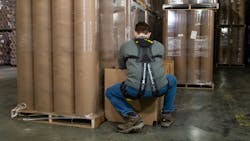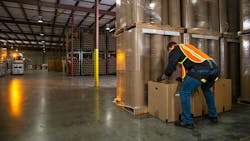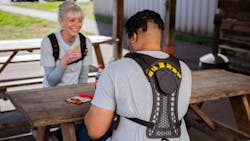Workplace Exoskeletons: 4 Myths That Need to Go
What You'll Learn
- Learn the different types of exoskeletons and how they can improve comfort and performance on the job.
- Understand how exoskeletons reduce worker strain without adding superhuman strength.
- See why customization and adjustability drive adoption across diverse workforces.
- Discover strategies for successfully implementing exoskeleton programs in your workplace.
Exoskeletons: A word often misunderstood, thanks to sci-fi portrayals, rapidly advancing technology, and misinformation. However, in warehousing and adjacent industries, this word is slowly but surely becoming synonymous with practical safety and injury reduction.
Occupational exoskeletons (exos) are becoming popular in workplaces as wearable assistive devices, but there are still many myths and misconceptions surrounding the safety technology. There are harmful misrepresentations floating around that insinuate incomplete ideas. Some overestimate the capabilities, such as "all exos give you superhuman strength," while others underestimate the current state of the technology, believing "exos limit range of motion and are too hard to implement into a workforce."
Not only are these notions false, but they are also likely to prohibit the adoption of new, impactful safety technology for many industries that can save thousands of workers from discomfort and strain. Workers who bend and lift heavy materials repeatedly put an immense amount of stress on their spines every day, causing strain and musculoskeletal disorders (MSDs). This strain is often due to overexertion, which is the number one cause of injury for workers in the U.S. in logistics, manufacturing, retail, and other industries, according to Liberty Mutual's 2024 Workplace Safety Index. But that strain can be dramatically eased with new exos.
As a relatively new type of safety technology being adopted and deployed across workplaces, misinformation around the wearable device can be a result of innocent confusion and simple misunderstanding about what an occupational exo is, and what it isn't. Academic and industry research are paving the way for a better industry understanding of the occupational exoskeleton, and support the idea that exos are impactful in reducing injury risk, increasing productivity, and more.
Becoming well-informed and opposing the spreading of misinformation about innovative safety technology isn't only beneficial for one's own knowledge, but can also help a broad spectrum of workers and leaders down the road. Letting the facts speak for themselves, here are four common misconceptions about occupational exos in the workplace:
Myth #1: All exos are bulky, uncomfortable, and limit your range of motion
This misconception often stems from an incomplete understanding of the different types of exoskeletons available. The truth is, not all exos are designed the same.
Exos can be classified in a couple of ways: by their structure or by their power source.
Structure
Rigid exos have a firm frame that can sometimes be bulky and limit movement. In contrast, soft exos (or "exosuits") are made from flexible, textile-based materials that prioritize user comfort and a full range of motion. Soft exos are often a better choice for jobs that require bending and twisting.
Power Source
Elastic exos (passive exos) use springs or elastics for assistance. They are lightweight, making them suitable for long shifts. Motorized exos (powered exos) use a battery or motor to provide assistance, which is useful for "locking" a user into a sustained posture. However, motorized exos are much heavier and are often bulkier due to motors, batteries, and other components.
The key to successful adoption is selecting the right type of exoskeleton for the specific tasks and environment while piloting it with your workforce to ensure that it's comfortable to use for a full day's work.
Myth #2: Exoskeletons give you superhuman strength
Contrary to what you might see in science fiction, exoskeletons are designed to assist workers, not to give them "superhuman strength" to lift heavier loads. The goal is to make a job safer and reduce the risk of injury.
Studies show that exoskeletons are most effective at reducing injury risk and fatigue when the weight being lifted remains constant while the exo assists. In fact, most back-assist exos are designed to offload a maximum of 10 to 40% of the strain on a worker's back. Trying to provide more assistance can actually be uncomfortable for the user.
Myth #3: Exos are a one-size-fits-all solution for a workforce
While some exoskeletons are highly adjustable, a one-size-fits-all solution does not work for everyone (they are, at best, one-size-fits-most). Workers are a variety of sizes and shapes, so a successful exoskeleton program requires a model that can accommodate this diverse workforce.
The amount of adjustability an exo provides is crucial for comfort and user adoption, especially given that workers will be working rigorously and often for long hours. Exos that use modular designs that can be customized to fit users and their varying sizes are usually the most successful, due to their ability to fit a large range of worker sizes by swapping out components. Generally, rigid and motorized exos have less adjustability than their soft counterparts due to their design constraints.
Comfort is a critical factor for adoption, so leaders should thoroughly research different options to find a solution that can be tailored to the unique needs of their workforce. An exo needs to fit well for it to do its job protecting the worker.
Myth #4: It's too difficult to implement an exoskeleton program
No matter the industry, change management can be very difficult when implementing any new policies or programs. Exos are no exception, but that does not mean it's impossible to implement a workforce-wide wearable safety tech program. In fact, there are many companies successfully deploying exos in large numbers today, with sustained high adoption rates among large workforces.
Training both workers and leaders in the workplace is critical to ensure an exo deployment is successful. Any new technology or process deployment will require training to align on expectations and best practices, and to support the new way of doing things. When leaders know the answer to questions, can help with training, and understand the benefits of a new safety program, workers often feel more supported and confident, making them more likely to embrace the new technology.
The initial skepticism that workers exhibit when new technology is presented to a workforce is valid and understandable. But once workers see how safety tech like exos can benefit their lives in and outside of work—and how they are supported with solid change management—they will come around to the idea after experiencing it for themselves. For leaders, understanding the benefits for workers can amplify the opportunity for productivity boosts, leading to quick ROI and overall savings.
Safety technology is evolving quickly, so it's important to stay educated and find the right tech for your workers. Learning about different types of exos, their benefits and challenges, plus how to implement them among a workforce, can help companies make the best, most informed decisions for workers.
¹ Rodzak, K.M., Slaughter, P.R., Wolf, D.N., Ice, C.C., Fine, S.J., & Zelik, K.E. (2024). Can back exosuits simultaneously increase lifting endurance and reduce musculoskeletal disorder risk? Wearable Technology, 5, e17. https://doi.org/10.1017/wtc.2024.8
About the Author

Matthew Yandell, PhD
Matthew Yandell, PhD, is the chief innovation officer and co-founder of HeroWear. An engineer and hands-on innovator, Matt is a co-inventor of HeroWear's core technology and oversees the development and testing of its product line. He attended Vanderbilt University.



